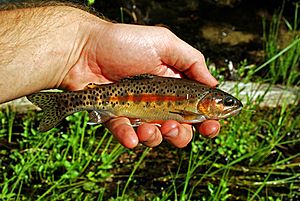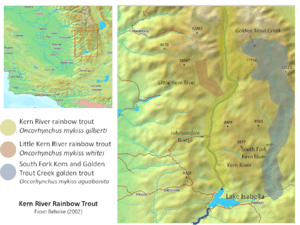Little Kern golden trout facts for kids
Quick facts for kids Little Kern golden trout |
|
|---|---|
 |
|
| Conservation status | |
| Scientific classification |
|
| Kingdom: | Animalia |
| Phylum: | Chordata |
| Class: | Actinopterygii |
| Order: | Salmoniformes |
| Family: | Salmonidae |
| Genus: | Oncorhynchus |
| Species: | |
| Subspecies: |
O. m. whitei
|
| Trinomial name | |
| Oncorhynchus mykiss whitei (Evermann, 1906)
|
|
 |
|
| Kern River trout range map | |
The Little Kern golden trout (Oncorhynchus mykiss whitei) is a brightly colored type of rainbow trout. It lives in the Little Kern River and its smaller streams in Tulare County, California.
This special fish is part of a group called the "golden trout complex." This group also includes the California golden trout, which is the state fish of California, and the Kern River rainbow trout. They all live in the Kern River area.
Contents
How Scientists Named This Fish
Scientists are always learning new things about how different fish species are related. The Little Kern golden trout has had a few name changes over the years.
The first time this fish was officially described was in 1906. A biologist named Barton Warren Evermann named it Salmo Whitei. He wrote about it in his book, ...The Golden Trout of the Southern High Sierras.
Evermann was sent to the Kern Plateau by President Theodore Roosevelt. Roosevelt's friend, Stewart Edward White, was worried that these beautiful trout were being caught too much. Evermann named the fish in honor of White, who helped bring attention to it.
Later, in 1989, studies on fish bodies and genes showed something new. They found that trout from the Pacific Ocean area were more closely related to Pacific salmon. This meant they were different from trout found in the Atlantic Ocean.
Because of this, in 1992, the Little Kern golden trout was reclassified. Robert J. Behnke decided it was a type of rainbow trout (Oncorhynchus mykiss). This led to the name we use most often today: Oncorhynchus mykiss whitei.
What the Little Kern Golden Trout Looks Like
The Little Kern golden trout is a very colorful fish. It has many black spots on its back and tail. Its belly and cheeks are usually bright orange or orange-red.
The lower sides of the fish can be light yellow to bright gold. Its back is an olive green color. The fins on its chest, belly, and near its tail are orange with white tips.
Unlike many rainbow trout, the Little Kern golden trout keeps its "parr marks" as an adult. These are up to ten dark, vertical stripes along its sides. Sometimes, there are even smaller parr marks above or below the main ones.
This trout looks a bit like the California golden trout and the typical coastal rainbow trout. The Little Kern golden trout's colors are usually a little less bright than the California golden trout. It also tends to have more black spots on its back and head.
Compared to coastal rainbow trout, Little Kern golden trout usually have fewer, larger, and rounder spots. In their natural small streams, these fish rarely grow longer than 12 inches (30 cm). A fish longer than 10 inches (25 cm) is considered quite large!
Where These Fish Used to Live
Historically, the Little Kern golden trout lived in about 100 miles (160 km) of the Little Kern River. This included the main river and all its smaller streams. They lived above a natural waterfall that stopped them from moving into the main Kern River.
Saving the Little Kern Golden Trout
The Little Kern golden trout faced a big problem. Other types of rainbow trout were introduced into their waters. These new trout bred with the golden trout, creating "hybrid" fish. This meant the pure Little Kern golden trout started to disappear from many areas.
By the 1960s, they were only found in about 8 miles (13 km) of small streams. These streams were above three natural barriers that protected them.
To help solve this problem, people stopped putting non-native trout into the rivers in the 1950s. In 1965, the California Department of Fish and Game (CDFG) started surveys to plan how to restore the fish.
Scientists at UC Davis began studying the fish's genes in 1976. They found what they believed were six pure groups of Little Kern golden trout.
Restoration efforts began in 1975. They used a special treatment called rotenone to remove non-native fish from the historic habitat. After this, pure Little Kern golden trout were put back into the streams. These fish came from the Kern River Fish Hatchery near Kernville, California. They were bred from the "pure" groups found earlier.
Other efforts included building barriers to stop non-native trout from moving upstream. They also improved stream habitats that were damaged by cattle. Public education and ongoing monitoring of the fish and their habitat also helped. By 1996, many believed the restoration was complete.
Challenges in Saving the Fish
Later studies showed that the restoration efforts had some challenges. One of the six groups of fish used for breeding was actually a mix of California golden trout and rainbow trout. Also, one individual fish used for breeding was found to be a hatchery rainbow trout. This meant that some hybrid fish were accidentally put back into the Little Kern habitat.
Another challenge was that the original pure fish came from small streams. These small groups had low genetic diversity. This means they might have lost some of their natural ability to adapt. Scientists worry this could make them more vulnerable to diseases or climate change.
Scientists are still working to understand how to best help these unique fish. They want to make sure the Little Kern golden trout can thrive in its native home.


